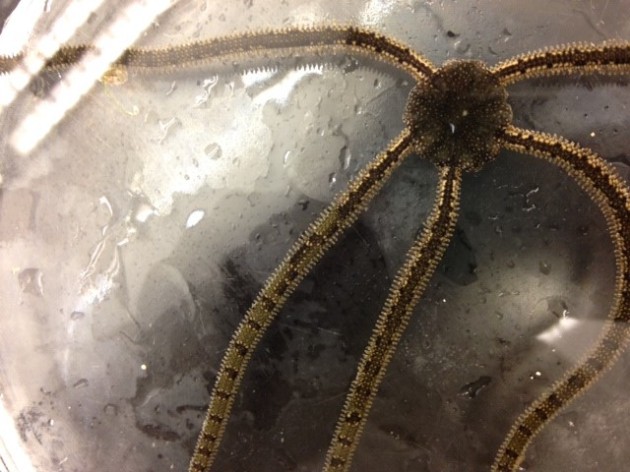For most people, sea stars, commonly referred to starfish (class Asteroidea), are certainly the most familiar class of the phylum Echinodermata. I used to be one of those sad individuals… until I had the opportunity to explore the various organisms belonging to this phylum! Many of the assorted species had interesting traits, but I was especially fascinated by the odd, spiny creatures known as brittle stars (class Ophiuroidea).
Brittle stars, like many echinoderms, exhibit pentaradial symmetry, essentially meaning that they have five arms. They basically look like a circle with five snake-like appendages protruding from their sides, which is why some people think them to be extremely skinny asteroids. Unlike the common starfish whose arms blend seamlessly into their body, brittle stars’ arms are clearly defined and separated from the central disk, as you can see in the above image. Their slithery arms are covered in hard spines and contain well-developed ossicles that maintain their structural integrity. However, my interest in brittle stars did not lie within these characteristics; I was instead intrigued by their distinctly different tube feet and usage thereof.
Tube feet are typically associated with the starfish (asteroids), seeing as their presence is quite obvious within this class. They occupy the ventral side of each sea star’s arm, reaching out with their suckers to grasp ahold of various substrates, they also facilitate locomotion, and bring food to its centrally-located mouth. They additionally play a role in respiration and sensory functions.
Like asteroids, brittle stars (ophiuroids) also possess tube feet on their arms. But though they share a name, the tube feet of brittle stars are actually quite dissimilar from those of sea stars. The most obvious difference is their appearance. The asteroid’s tube feet are long and thin, extending far beyond the confines of the ambulacral groove (the indentation that houses them). Additionally, each tube foot has a conspicuous sucker at the end of it, used for grabbing various substances (food, rocks, coral, whatever it may encounter). The ophiuroid’s tube feet, as shown below, are rather short and stubby in comparison, and completely lack suckers!

The tube feet of the brittle star Ophioderma panamense—clear and somewhat stout, visible between the spines. Image Credit: Rainna Lim
Activity is another difference between the two classes. Asteroids’ tube feet are almost constantly moving, extending and retracting to get a sense of their surrounding environments. In contrast, when I was examining a brittle star under the microscope, its tube feet did not seem to move frequently, if at all, during that time. Why, then, did they exist? The survival of an asteroid relies mainly on its tube feet, and it’s clear why—those little guys are capable of practically anything. But those of the ophiuroid seem to not serve any real purpose…or so one may think! As I discovered, brittle stars actually utilize their tube feet for gas exchange and sensing their surroundings (Pechenik 2010). Ophiuroids’ tube feet also occasionally reject overly large particles that are too bulky to digest (Allen 1998). For those that are suspension feeders instead of deposit feeders, the tube feet make little food packages that travel down the arm to the mouth by gathering particles and wrapping them in mucus (Pechenik 2010). Some species possess little bumps on their tube feet called papillae on which most particles accumulate (Pentreath 1970). Contrastingly, deposit feeders use their tube feet to directly consume food particles (Pentreath 2010). (Now, I know what you must be thinking at this point. If tube feet don’t contribute to locomotion, then what does? The ophiuroids actually move by using their arms as “oars”, which help them glide along the ocean floor. Tube feet are rarely involved in this process, seeing as they are quite reduced.)
If you take one thing away from this lesson, let it be that tube feet are amazing appendages! Even though they might not look as fancy in some classes compared to others, their multiple functions never fail to impress.
References
Pentreath, RJ (1970) Feeding mechanisms and the functional morphology of podia and spines in some New Zealand ophiuroids (Echinodermata). Journal of Zoology, Lond 161: 395-429
Allen, JR (1998) Suspension feeding in the brittle-star Ophiothrix fragilis: efficiency of particle retention and implicationsfor the use of encounter-rate models. Marine Biology 132: 383-390
Pechenik, Jan A. (2010) Biology of the Invertebrates. Boston: McGraw-Hill, Higher Education.

